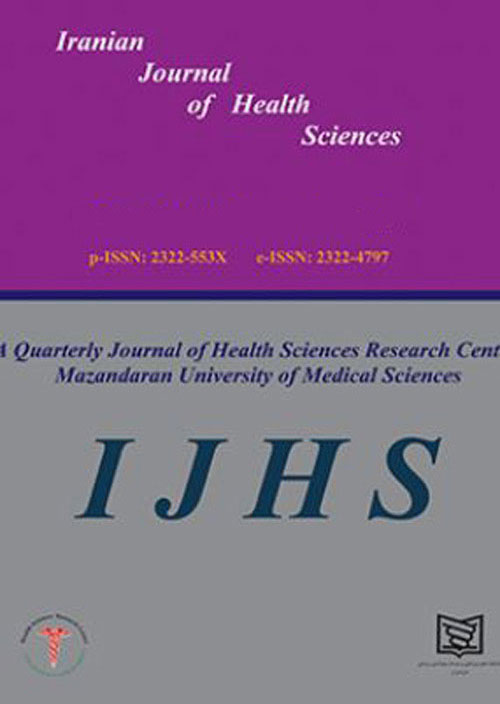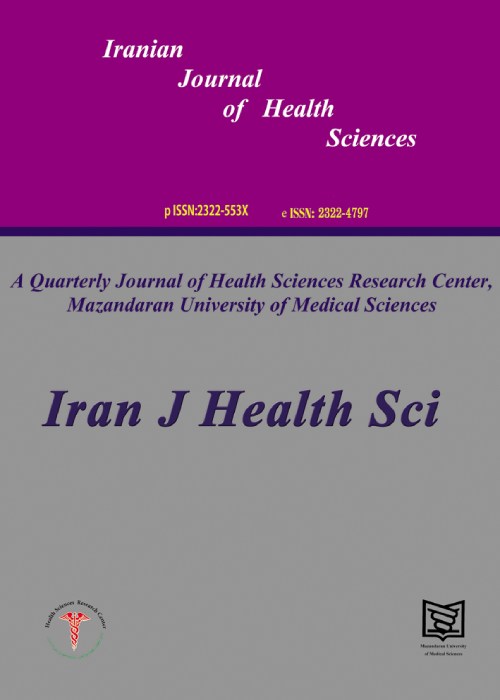فهرست مطالب

Iranian Journal of Health Sciences
Volume:9 Issue: 2, Spring 2021
- تاریخ انتشار: 1400/03/28
- تعداد عناوین: 5
-
-
Pages 1-8Background and Purpose
Hospital readmission after kidney transplantation is a real challenge for both patients and healthcare systems. Assessment of the risk factors of readmission after kidney transplantation is vital and can reduce morbidity and cost in transplant recipients and donors. The aim of the current study was to determine the risk factors of hospital readmission in patients undergoing kidney transplantation in Montaserieh Hospital of Mashhad, northeast of Iran.
MethodsThis retrospective study included 523 first kidney transplant patients between January 2013 and March 2019 from the Montaserieh Hospital Information System (HIS) of Mashhad, Iran. Every-time readmission was the study primary outcome. Donors and recipientchr('39')s demographic data, recipientchr('39')s comorbidities, reasons for end-stage renal disease (ESRD), panel reactive antibody (PRA) status, dialysis parameters, cold ischemic time, and delayed graft function (DGF) were the potential risk factors. Statistical analysis was done using chi-square and Studentchr('39')s t-test.
ResultsData from 523 patients were assessed for potential eligibility. Based on the exclusion criteria, data from 479 patients were included in the final analysis. 174 (36.3%) patients were never readmitted, and 305 (63.7%) were readmitted at least once post-discharge. 39 (12.8%) were readmitted within the first month post-discharge. Older age, sex, higher prevalence of comorbidities, diabetes and hypertension, duration of primary disease before transplantation, hemodialysis and duration of pre-transplant dialysis, mean pre-transplant platelet count, intraoperative complications, increased cold ischemic time, and delayed graft function was associated with a higher prevalence of readmission (p < 0.05).
ConclusionOur results showed that different independent variables and patientschr('39') comorbidities were important risk factors for readmission after kidney transplantation. Early prediction of these risk factors could result in the prevention of readmission in patients undergoing kidney transplantation.
Keywords: Kidney transplantation, Readmission, Risk factors, Comorbidity -
Pages 9-17Background and Purpose
Survival tree model is a nonparametric method which can be used to identify the affecting factors from a specific time to the onset of an event. In this method, the categories are selected according to the most important factors. The purpose of this study was to determine the factors affecting the duration of breastfeeding in mothers and introduce the homogeneous subgroups using a survival tree model.
MethodsIt was a historical cohort study analyzing the survival data of mothers with healthy single childbirths referring to the rural and urban health centers of Agh-Ghala County since 2011 until 2014. Data analyses and groupings of breastfeeding survival were performed using survival tree model with conditional inference algorithm in R Software. A separation criterion (SEP) confirmed the relevance of the model.
ResultsSurvival tree model results revealed that the type of consumed milk with the complementary nutrition, ethnicity and the time interval between current childbirth and the previous delivery were the most important factors affecting the duration of breastfeeding. The SEPchr('39')s criterion was 2.082. Thus, due to the significant difference between the subgroups and the value of more than 1 for SEP criterion, the efficiency of the model was confirmed.
ConclusionsSurvival tree model could be introduced as a suitable and powerful method for ranking the duration of breastfeeding rate which presents four homogeneous subgroups for analysis in addition to identifying the predictive variables.
Keywords: Survival Tree, Conditional Inference Algorithm, Homogeneous Subgroups, Duration of Breastfeeding -
Pages 18-27Background and purpose
The human immunodeficiency virus (HIV) include blood-borne viruses that have infected millions of people worldwide. During haircut or shaving, barbers may accidentally expose their clients’ blood, transmit their own infection to them, or transmit the infection from one client to another. Hence, the knowledge of barbers toward topics related to AIDS is of great importance. The aim of the present study was therefore to evaluate the knowledge and performance of hairdressers about HIV/AIDS based on the theory of planned behavior.
Materials and MethodsIn this cross-sectional study, 275 hairdressers were systematically and randomly selected from five points in Sari. The data were obtained through self-design questionnaires. Data analysis was performed using SPSS 23.
ResultsOf the total 275 participants, 236 (85.8%) were female and 39 (14.2%) men. Among participants, 14.2% were less than 25 years of age, and 10.9% of participants were more than 44 years old. According to the correlation results, there was a statistically significant relationship between the intention with knowledge, attitude, and performance score of the hairdressers. As well, a significant correlation was observed between subjective norm with knowledge, attitude, performance, and perceived behavioral control with four variables.
ConclusionThe results showed that the level of hairdresserschr('39') knowledge, attitude, and performance about preventive behavior of AIDS in the workplace was optimal. Behavioral intention, subjective norms, and perceived behavioral control of hairdressers can be considered effective factors in awareness, attitude, and performance. In spite of all that, educational programs were found to be necessary for raising hairdresserschr('39') awareness, and their performance was emphasized as one of the strata of society that deals with human health.
Keywords: Theory of Planned Behavior, Knowledge, Performance, AIDS, Hairdressers -
Pages 28-39Background and Purpose
Phytoremediation efficiency of heavy metals is an important factor in environmental studies. This study was conducted to investigate the effect of multi-walled carbon nanotubes (MWCNTs), zeolite, and P.indica on bio-degradation of mazut in a soil treated with Cd and mazut.
Materials and MethodsTreatments consisted of applying zeolite (0, 1 and 2% (W/W)), MWCNTs (0, 1 and 2 % (W/W)) in the presence and absence of P.Indica in the Cd (0 , 5 and 10 mg/kg soil) polluted soil that was simultaneously polluted with mazut (0 and 6 % (W/W)). After 70 days, plants were harvested, and plant and soil Cd were measured using AAS. In addition, the degradation percentage of mazut in soil was determined.
ResultsThe addition of 2 % (W/W) MWCNTs and zeolite to the soil polluted with 6 % (W/W) mazut significantly increased the bio-degradation percentage of mazut in the soil by 11.3%. For soil and plant Cd concentration, it was decreased by 10.6 and 12.8%, respectively. In addition, plant inoculation with P.indica significantly increased the biodegradation of mazut in the Cd polluted soil (10 mg Cd/kg soil) by 14.3%. Increasing soil pollution to mazut from 0 to 6 % (W/W) significantly increased the soil microbial respiration by 14.4%.
ConclusionBased on the results, the addition of MWCNs and zeolite in the soil and plant inoculation with P.indica significantly increased the mazut bio-degradation in the soil. However, the amount and type of pollutant had a significant effect on phytoremediation efficiency.
Keywords: Pollution, Phytoremediation, MWCNTs, Zeolite, Microbial Respiration


